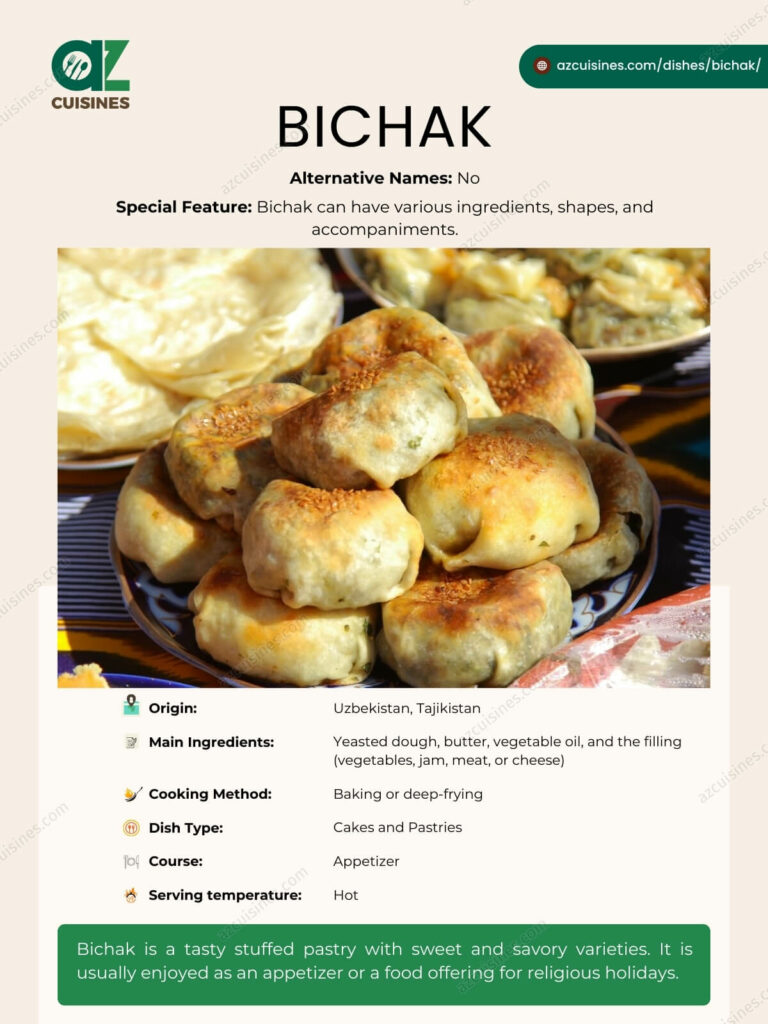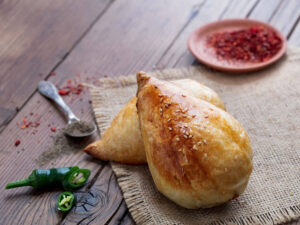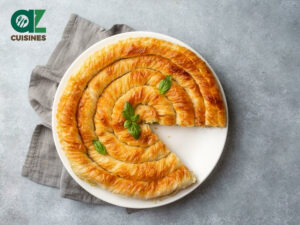Bichak: Basic Information
Pronunciation
Alternative Name(s)
Dish Type
Course
Mealtime
Popular Variations
Bichak: Ingredients and Preparation
Main Ingredients
Main Cooking Method
Preparation Process
Bichak: A Deep Dive
Cultural Significance
Taste
Texture
Aroma
Color
Serving Style
Serving Temperature
Accompaniment
Occasions
Seasons
Special Diets
Calories
Popularity
- Central Asia: Uzbekistan, Tajikistan
- West Asia: Israel, Arab and North African countries, especially Morocco
- Others: Afghanistan
Popular Similar Dishes
- Chebureki
- Samsa
- Empanada
- Pirozhki
- Börek
Popular Dining Area
Bichak is a type of stuffed pastry that hails from Central Asia, such as Uzbekistan and Tajikistan.
Bichak is particularly beloved in Bukharan Jewish cuisine, which is the cuisine of the Jews in Bukhara, Uzbekistan.
The stuffed pastry is also well-known in Morocco, Israel, and in Afghanistan.
People prepare bichak by folding a piece of yeasted dough over a sweet or savory filling into a triangular, quadrangular, or round turnover.
Bichak is then baked or fried until crispy and served with tea or coffee. Jews usually have bichak with yogurt and sour cream.
Sweet bichak has jam, fruits, or vegetables like pumpkins or spinach for the filling, while savory bichak consists of meat or cheese. The meat and vegetables are typically sautéed with onions and spices for more flavors.
Do you want to know about the pros and cons of bichak, questions people usually ask about the pastry, and similar dishes about the world? Continue reading, and such information will be yours!
Key Points
Bichak Images
Pros and Cons of Eating Bichak
Bichak has the following strengths and weaknesses:
Pros
Cons
Don’t stop at just knowing about these pros and cons; you should also learn the common concerns other readers have about bichak.










Adam Sam
Senior Food and Drink Editor
Expertise
Food Writer & Recipe Developer, Recipe Tester, Bartender, Cooking-video Maker, Editor In Chief
Education
Adam Sam, an experienced food writer and recipe developer, is passionate about blending diverse culinary traditions, national dishes, and innovative beverages, showcasing his proficiency in both traditional and modern recipe testing.
As the Editor-in-Chief, he elevates culinary content from street food to fine dining, focusing on Western cuisine and types of drinks at azcuisines.com, and is professional in creating engaging cooking videos that simplify complex dishes and ingredients.
His passion for food is evident in his writing, where he uniquely merges various cultures, traditions, and contemporary trends, skillfully combining classic recipes with modern cooking methods.